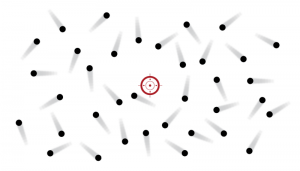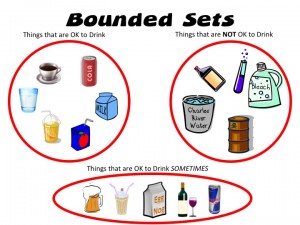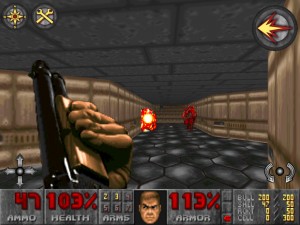Shoot! Clearly I am not cut out for blogging! It’s been months since my last post. Sadly, I think my dreams of having one of those blogs that people actually read are down the drain. And yet, I put the link to this thing on my business cards and I’m too cheap to get new ones before I use these up.
And speaking of my business card, what’s up with the backside of that thing? I gave one to a young woman and she giggled when she looked at the back. When I asked her what was funny, she said “well, you know what this looks like!” But I didn’t. And she didn’t want to clue me in for some reason and then she changed the subject.
I kept trying to figure it out though. I had just ordered a fresh box of these business cards so I wanted to be in on the joke too. The demure tone of her snickering made me wonder if it was something sexual. And then I had my answer. Well, here’s what’s on the back and you’ll probably pick up on it much faster than I did.
Well, if I wasn’t meaning to depict a bunch of sperm cells bombarding the egg, what is the deal with this image?
Well, I’m glad you asked, oh attentive reader!
This little diagram represents why I, an introverted science nerd, wanted to become a chaplain whose work centers around conversations. It represents the paradigm shift that has changed my life. And I think it’s probably the best thing that I have to offer MIT. It is the centered set.
Ok, so now I will attempt to explain. Let’s talk about some set theory. But this is not 18.901 or even 6.042-level set theory. This is like kindergarten-level set theory.
So there are two types of sets we’ll consider, two different ways of describing objects in the universe. Bounded sets and centered sets. First bounded.
A bounded set is just a circle, a boundary. Whatever is inside the the circle is in the set and everything else is outside. So, as I sit in this Starbucks, I am in the bounded set of people in this starbucks. But then within that set I can draw more circles. I would be in the bounded set of males in the room, but (ironically) outside the set of coffee drinkers. Pretty straightforward.
Bounded sets are very intuitive and very important for getting through life. I like to keep a mental bounded set of things that are ok to eat and things that are ok to say in polite company. They keep me on track.
Now, I’m in the religion business (though I don’t really like the R-word that much) and you can see how bounded sets would apply there. There would be a bounded set of people who are Christians, a bounded set of Jews, Muslims, agnostics, atheists, etc. We could draw lots of circles to represent all the religious categories and sub-categories. And I think it’s pretty automatic that we tend to put people into categories (wrt to religion and everything else) and these categories have a lot of influence on how we think about people and interact with them. More on this later.
Ok, now let’s talk centered sets. With centered sets, there’s no boundary, but there is a center or an origin. And then all the objects in our universe have some spatial relationship to that center. Some things are close to the center, other things are far away. And it’s quite natural for the centered set universe to be dynamic rather than static. So all our objects have some vector of motion, some trajectory that they’re on. This motion is also in relation to the center, taking some more towards the center, others further away from it.
Centered sets are a little less intuitive and less a part of our everyday experience. I have to think a bit to come up with some good examples. Here’s one: let’s say I have a room full of people and I ask myself the question who here is “nice”? Bounded sets are probably somewhat lacking in this area because there tends to many shades of gray with niceness. We all know the guy in the corner is not very nice. But most of the people here are pretty nice. And then there’s that one girl who is exceedingly nice.
The ramifications that this paradigm shift can have on our approach to religion and spirituality are quite profound, even if they take some teasing out.
In recent years, a lot of smart people have been telling us about all the ways that religion screws things up. It’s causes wars, it breeds intolerance and bigotry, it’s anti-intellectual, it’s imperialistic and ethnocentric and it’s often corrupt and hypocritical. And I’m sure many things could be added to this list.
What’s interesting to me is, that I think all of these things are rooted in bounded-set thinking. Bounded sets cause us to focus on who’s in and who’s out, who’s right and who’s wrong. In this mode, it’s very difficult to not judge the people outside our own bounded set. It’s probably just a matter of time before we see them as inferior, wrong or even evil.
Bounded sets also tend to discourage progress and growth because, once I’m in my bounded set, I don’t tend to want to move. I settle in and get comfortable there because the whole emphasis is being in the “right” group. And since I’m in the right group, why should I move? It’s good for me to stay right here. In fact, I’m helping the world by staying put, I’m one of the good guys. It’s always the other person who needs to move, get their act together, shape up. It’s always other people in those other bounded sets who are the source of the world’s problems. And you can probably connect the dots from here to all those bad things that are associated with religion.
But there is another way! Enter the centered set. In the centered set, my goal is not to be in the “right” set, my goal is to move towards what is good, to move towards the center. The challenge of this paradigm shift is that I have to resist the temptation of self-righteousness and my very strong desire to be and feel “right” (I really do love being right… ask my wife). The incredible upside is that my attention is refocused on ever-increasing connection with something good, something powerful, something transformative.
Another game-changing aspect of centered set thinking is that everyone is on the same playing field. There’s no in group or out group, no good guys or bad guys, just people. I like this because it feels a lot like real life to me. We’re all human and we’re all here trying to live the best life that we know how to live. So in that sense, the center that we’re all orbiting and trying to move towards is what we might call “The Good Life”.
Now, clearly we may have vastly different notions on how to define that good life and how to make progress towards it, but we’re still engaged in the same fundamental endeavor.
So, just for argument’s sake, let’s say that there is some center out there somewhere. And even if we call it different things and describe it differently, let’s say that there is one center (to avoid having a center over here for me and my friends, another one over there for this group and one over yonder for that other group–that will just take us back into bounded set territory) and that one center equates to experiencing the best, most fulfilling life that we can imagine.
This scenario has some pretty profound implications. First off, it means that every single person on earth has something really important to teach me. Because every single person knows something about the center that I might not know. If we’re paying attention, all of our life experience is giving us feedback about what the center is and how to get there. But the information anyone of us has is pretty minuscule and may not get us very far. So being able to learn from other people, traditions, cultures and worldviews is immensely valuable.
Next, as mentioned earlier, the centered-set paradigm is intrinsically dynamic. It assumes that we’re always moving, that things are in flux, that life is not static. This reminds me that I’m always on a journey and always still in process. It reminds me that life’s ups and downs are to be expected and that they don’t mean I’m doing something wrong or that things need to be “fixed.”
Centered-set thinking forces me to be humble. In bounded-set land, we tend to think that we have a bird’s-eye view of reality, that we have enough perspective to definitively say that this set is the right set. But the perspective one has in centered-set thinking is much more limited. It’s much more like being in a first-person-shooter game. It reminds me that I’m only one little dot in a big universe and I can only see as far as I can see.
And the whole idea is that I’m not at the center. So I can’t say with certainty what the center is or where it is. Not that I’m totally clueless about the center. I still have all the bits and pieces of knowledge that I’ve gleaned from my experience and the experience of others. Over time I can begin to loosely sketch out my picture of the center and how to get there (see my next post on centered sets). I just have to remember that it’s just a best guess based on limited and subjective information.
I’ve talked to plenty of people who just can’t, in the end, get excited about centered-sets and for whom bounded sets are the way to go. But I’ve also talked to many people for whom centered-sets provide what seems like a life-saving breath of fresh air. In any case, I find myself hopeful that a centered-set approach to spiritual engagement could be helpful to many people at MIT.






I like the centered set theory very much. It’s open and as you say, dynamic. I like less the earlier blog about being child like in god-belief. The common word that comes to mind is “open”. I’m no longer sure who said, but it has been written that a measure of a man’s intelligence is his ability to live in doubt. I rather like the idea of the adult being “open” as a child is but with the knowledge of an adult. Use of the word child seems to require an adult to be reduced in some way. But being “open” does not require being reduced.